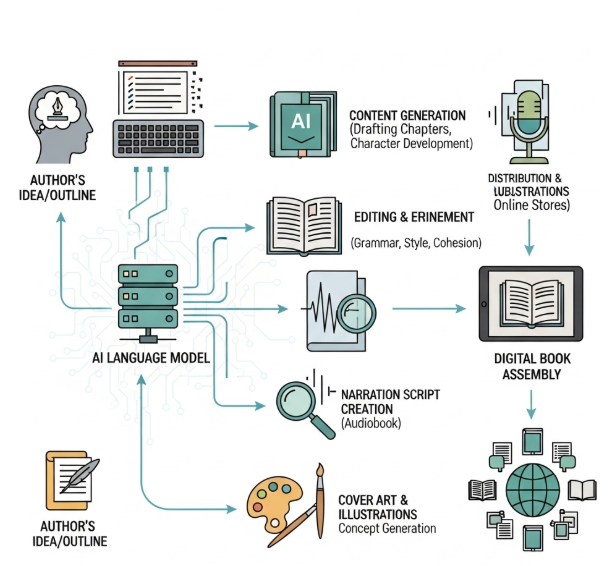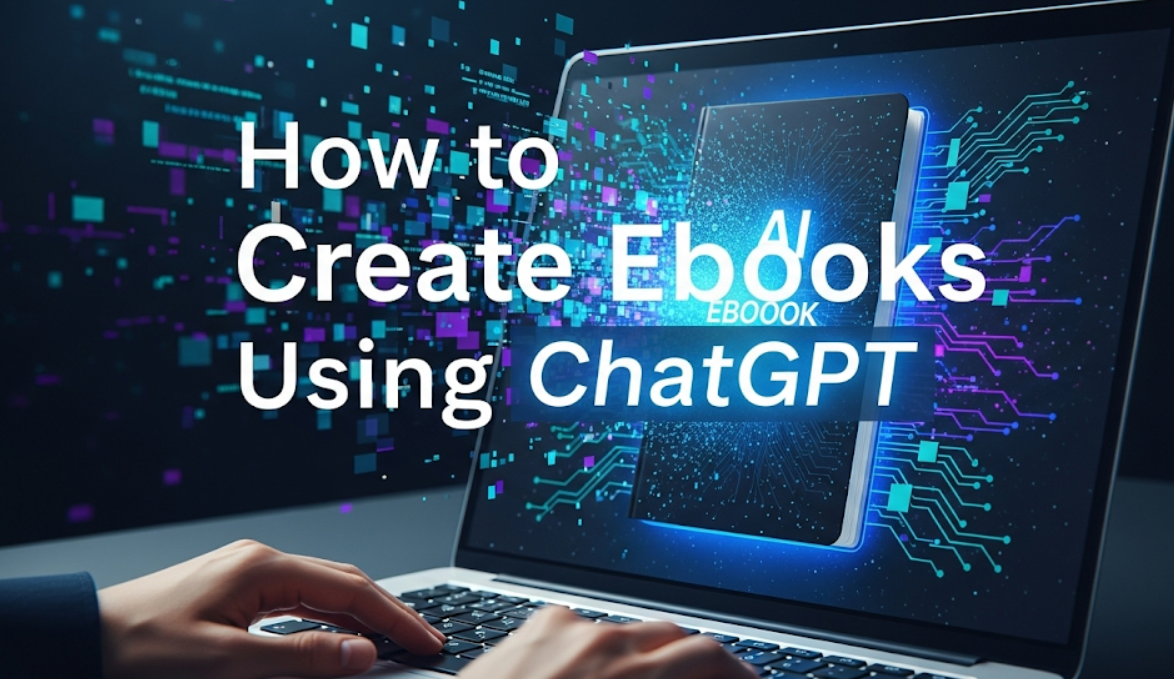With the help of AI tools such as ChatGPT, generating an ebook has become a walk in the park. In this guide, you are going to learn how to transform your ideas into a professional digital book using the powerful writing capabilities of ChatGPT whether you are an author, business owner, or content creator.
The era of the ebook is alive, well, and absolutely booming with millions of book lovers getting their books in digital form because it’s instant and easy. When you learn to create ebooks with ChatGPT, you are learning to be a part of an industry that is worth $15 billion and still grows every year.
Why ChatGPT is the Best For Ebook Production
The emerging technology of ChatGPT can fundamentally transform the process of how an ebook gets written. AI (such as this tool) is the answer to your prayers; whether it is for idea harvesting, outline creation, content generation, or final draft polishing. The best part? It never gets writer’s block, and it goes 24/7.
Why ChatGPT is best for ebook writing:
- Faster: Can write thousands of words in minutes
- Consistency: Keeps your tone straight throughout the whole book
- Research Helper: Offers information about anything
- Multi-format: Produces content for various e-book formats
- Cost-effective: More affordable than employing professional writers
Steps to Write Your First Ebook
Step 1: Pick Your Ebook Topic & Niche
Before we get to ChatGPT, let’s start with your ebook foundation. Ebooks that solve a problem or teach the reader something are extremely effective.
Popular ebook niches include:
- Health and fitness guides
- Business and marketing strategies
- Self-help and personal development
- Technology tutorials
- Cooking and recipes
- Travel guides
- Investment and finance advice
Prompt example for topic brainstorming: “10 most profitable ebook topics in [your niche] helping [target audience] solve common problems. Add potential chapter names for each topic.”
Step 2: Write a Comprehensive Ebook Outline
A good outline is your compass. ChatGPT is excellent for creating logical and comprehensive outlines for your ebook from the introduction to the conclusion.
ChatGPT Outline Template:
Outline an ebook ‘[Your Title]’ for [your audience]:
– Hook/Overview
– Introduction — word count?
– Main Chapters with 3–4 points each (6–8 chapters)
– Desired word count for each section
– Estimated total word count
– Conclusion/Takeaways
| Chapter Type | Word Count Range | Intent |
| Introduction | 500-800 words | Acquaint readers, convey objectives |
| Main Chapters | 1,500-3,000 words | Present main content |
| Conclusion | 400-600 words | Wrap-up and takeaways |
| Appendix | 200-500 words | Additional resources |
Step 3: Research & Collect Data
While ChatGPT’s knowledge base can help, the more research you do here, the better your ebook and, in turn, your credibility with readers. Have the AI assist you in gathering information from different sources.
Research prompts that work:
- “2024–2025 [Topic] trends roundup”
- “Common mistakes people make with [your topic]”
- “[Your ebook subject]: Latest statistics and data”
Step 4: Create Your Ebook Content with ChatGPT
Now the fun part: writing your ebook. Work on one chapter at a time to break this process into manageable chunks.
Effective writing prompts:
Write a 2,000-word chapter titled “[Chapter Title]” for an ebook on [topic].
Include:
– Beginning: An engaging opening
– Practical examples and case studies
– Tone: Conversational
– Ending: Actionable steps
– Audience: [Your target readers]
Tips to generate better content:
- Target your specific audience in every prompt
- Request specific word counts
- Ask for examples and case studies
- Include formatting preferences
- Request bullet points and numbered lists
Step 5: Maintain Consistency Across Chapters
Using the same tone, style, and writing level will keep your readers engaged. Create a style guide and reference it whenever you prompt ChatGPT.
Style guide elements:
- Voice and tone (conversational vs. professional)
- Preferred sentence length
- Use of jargon or technical terms
- Formatting preferences
- Chapter structure template
Step 6: Add Engaging Elements
Transform your ebook into an engaging experience by adding different types of content.
Elements to include:
- Case studies: Real examples to support your points
- Action lists: Practical to-dos readers can implement
- Templates: Ready-to-use frameworks
- Infographics: Visual representations of data
- Tables and charts: Data made digestible
ChatGPT prompt for interactive elements: “Create a [specific process] checklist that readers can use after reading chapter [X]. Format it as a checklist with checkboxes and actionable steps.”
Advanced ChatGPT Tactics for Ebook Creation
Persona-Based Writing
Use different personas within ChatGPT to write various sections of your ebook. This method introduces variety and freshness in content.
Example personas:
- Expert advisor for technical sections
- Friendly mentor for motivational parts
- Practical coach for action-oriented chapters
Sequential Chapter Development
Link chapters together rather than writing them individually.
Linking prompt: “I just finished a chapter about [subject]. Write the first two paragraphs of the next chapter that smoothly transitions into discussing [new subject].”
Content Expansion and Depth
Transform simple concepts into detailed explanations through strategic prompting.
Depth-building prompts:
- “Expand on the concept of [topic] with three detailed examples”
- “Explain [concept] as if teaching a beginner”
- “Advanced strategies for [topic] practitioners”
Editing Your AI-Generated Content
ChatGPT content is a solid foundation, but it needs human refinement to reach publication quality. Here’s your editing workflow:
First Pass: Structure and Flow
- Check logical progression between chapters
- Ensure smooth transitions
- Verify all promised content is delivered
- Remove redundant information
Second Pass: Clarity and Readability
- Simplify complex sentences
- Replace jargon with plain language
- Add relevant examples
- Improve paragraph breaks
Third Pass: Fact-Checking and Updates
- Verify statistics and claims
- Update outdated information
- Cross-reference external sources
- Ensure accuracy of technical details
Final Pass: Grammar and Style
- Correct grammatical errors
- Maintain consistent tone
- Fix formatting issues
- Polish overall presentation

Formatting Your Ebook for Publication
Choose Your Format
Different platforms require different formats:
- PDF: Universal compatibility, maintains formatting
- EPUB: Standard for most ebook readers
- MOBI: Amazon Kindle format
Design Considerations
Essential design elements:
- Professional cover design
- Consistent font choices
- Proper spacing and margins
- Chapter headers and page numbers
- Table of contents with links
- Copyright and disclaimer pages
Tools for Ebook Formatting
| Tool | Best For | Cost |
| Canva | Cover design, simple layouts | Free – $15/month |
| Vellum | Professional formatting | $250 one-time |
| Reedsy Editor | Professional formatting | Free |
| Microsoft Word | Basic formatting | $70/year |
| Adobe InDesign | Advanced design | $21/month |
Publishing Platforms and Distribution
Major Ebook Platforms
Amazon Kindle Direct Publishing (KDP)
- Largest ebook marketplace
- 70% royalty option available
- Global distribution
- Print-on-demand services
Apple Books
- iOS and Mac users
- High-quality presentation standards
- International reach
- 70% royalty rates
Google Play Books
- Android integration
- Global availability
- Various pricing options
- Easy upload process
Additional Platforms:
- Barnes & Noble Press
- Kobo Writing Life
- Smashwords
- Draft2Digital
Self-Publishing vs Traditional Publishing
| Aspect | Self-Publishing | Traditional Publishing |
| Control | Complete creative control | Publisher has final say |
| Royalties | 35-70% | 8-15% |
| Timeline | Immediate publishing | 6–18 months |
| Marketing | Self-managed | Publisher support |
| Upfront costs | Minimal | None |
Marketing Your ChatGPT-Created Ebook
Pre-Launch Strategy
Build anticipation:
- Create social media teasers
- Start an email list
- Share behind-the-scenes content
- Offer pre-order discounts
Content Marketing
Leverage your ebook content:
- Extract blog posts from chapters
- Create social media quote graphics
- Develop video summaries
- Host webinars on key topics
SEO Optimization for Ebook Discovery
Keyword strategies:
- Research relevant long-tail keywords
- Optimize your book title and description
- Use keywords in chapter titles
- Create keyword-rich blog content
Social Proof and Reviews
Encourage reviews through:
- Follow-up email sequences
- Bonus content for reviewers
- Social media engagement
- Author networking
Monetization Strategies Beyond Direct Sales
Create Course Content
Turn your ebook into online courses for platforms like:
- Udemy
- Teachable
- Skillshare
- Your own website
Develop Complementary Products
Expand your ebook into:
- Workbooks and journals
- Audio versions (audiobooks)
- Video series
- Coaching programs
- Physical products
Build an Email List
Use your ebook as a lead magnet to:
- Grow your subscriber base
- Promote future books
- Sell related services
- Build a community
Common Mistakes to Avoid
Content-Related Errors
- Over-relying on AI: Remember to add that personal touch
- Ignoring your audience: Ensure your content provides value
- Lacking originality: Add your unique perspective
- Poor fact-checking: Verify all statistics and claims
Publishing Mistakes
- Rushing the editing: Polish your content thoroughly
- Neglecting cover design: Invest in professional-looking covers
- Incorrect pricing: Research competitor pricing
- Limited platform presence: Publish across multiple platforms
Marketing Oversights
- No marketing strategy: Plan promotion before publication
- Ignoring SEO: Optimize for discoverability
- Inconsistent branding: Maintain professionalism across all platforms
- Ignoring reader feedback: Respond to reviews and comments
Future of AI-Assisted Publishing
AI is becoming increasingly integrated into publishing. Future developments may include:
- Hyper-personalization: AI customizing content for individual readers
- Multimedia integration: Seamlessly combining text, audio, and video
- Real-time updates: Ebooks that update automatically with new information
- Interactive elements: AI-powered quizzes and personalized recommendations
Your Action Plan for Ebook Success
With ChatGPT, the possibilities for content creation are endless. Success lies in combining AI efficiency with human creativity and smart market strategies.
Step-by-Step Action Plan:
- Week 1: Choose your topic and create a detailed outline
- Weeks 2–3: Generate content using ChatGPT with strategic prompting
- Week 4: Edit and refine your manuscript
- Week 5: Design and format your ebook
- Week 6: Set up publishing accounts and upload your ebook
- Week 7+: Execute your marketing strategy
Key Takeaways
Remember, your first ebook is just the beginning. Each book you publish builds your brand, grows your audience, and creates another income stream. The combination of ChatGPT’s capabilities and your unique perspective can launch your ebook publishing journey to success.
Start today choose your topic and write your first ChatGPT prompt. Your future readers are waiting for the valuable, unique content only you can provide. With dedication and the right strategy, your ebook could become the next bestseller in your niche.
The digital publishing revolution is here, and ChatGPT is your gateway to becoming a successful author. Start now, and transform your expertise into a quality ebook that helps people worldwide while building your brand and creating lasting income.
FAQ
1. Why is ChatGPT best for ebook writing?
ChatGPT is faster, maintains consistency, helps with research, produces content in multiple formats, and is more cost-effective than hiring professional writers.
2. What are popular niches for ebooks?
Health and fitness, business and marketing, self-help, technology tutorials, cooking, travel, and investment/finance.
3. How do I create an ebook outline with ChatGPT?
You can prompt ChatGPT to create a structured outline including an overview, introduction, chapters with 3–4 points each, estimated word counts, and a conclusion.
4. How can I use ChatGPT for research?
You can ask for topic trends, common mistakes, or the latest statistics and data related to your subject.
5. What are effective writing prompts for ChatGPT?
Prompts should request specific word counts, practical examples, case studies, formatting preferences, bullet points, and actionable steps for your target audience.











